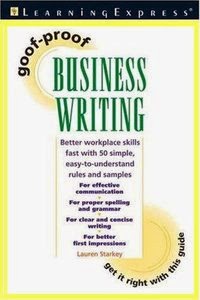Introduction
SECTION ONE
The Goof-Up—Disorganized Writing 1
Rule #1 Spend Time Prewriting 2
Rule #2 Choose an Appropriate Organization Method 4
Rule #3 Transform Prewriting into an Outline 5
Rule #4 Use Appropriate Headings and Salutations 7
Rule #5 Write a Strong Introduction 9
Rule #6 Use the Body of Your Writing to Present
Supporting Information 11
Rule #7 End with an Effective Conclusion 13
Rule #8 Use an Appropriate Closing 15
SECTION ONE
The Goof-Up—Disorganized Writing 1
Rule #1 Spend Time Prewriting 2
Rule #2 Choose an Appropriate Organization Method 4
Rule #3 Transform Prewriting into an Outline 5
Rule #4 Use Appropriate Headings and Salutations 7
Rule #5 Write a Strong Introduction 9
Rule #6 Use the Body of Your Writing to Present
Supporting Information 11
Rule #7 End with an Effective Conclusion 13
Rule #8 Use an Appropriate Closing 15
SECTION TWO
The Goof-Up—Being Unaware of Your Audience 17
Rule #9 Adapt Your Writing to Deal
with Multiple Audiences 18
Rule #10 Learn about Your Audience 20
Rule #11 Establish a Positive Impression
with Your Audience: Tone 22
Rule #12 Establish a Positive Impression
with Your Audience: Voice 24
Rule #13 Choose Words with Your Audience in Mind 25
Rule #14 Use the Correct Format 27
Rule #15 Remember the Human Element 30
Rule #16 Understand Your Audience’s Level
of Understanding, and Write to It 32
SECTION THREE
The Goof-Up—Writing without Clarity 35
Rule #17 Know What You Want to Say
Before You Say It 36
Rule #18 Choose the Right Words 37
Rule #19 Eliminate Ambiguity 39
Rule #20 Avoid Unclear Pronoun References 41
Rule #21 Be Brief 43
Rule #22 Don’t Repeat Yourself 46
SECTION FOUR
The Goof-Up—Choosing the Wrong Words 49
Rule #23 Learn the Most Commonly Confused
Words, and Use Them Properly 51
Rule #24 Learn the Most Misused Words,
and Use Them Properly 54
Rule #25 Don’t Use Words That Aren’t Really Words 57
The Goof-Up—Being Unaware of Your Audience 17
Rule #9 Adapt Your Writing to Deal
with Multiple Audiences 18
Rule #10 Learn about Your Audience 20
Rule #11 Establish a Positive Impression
with Your Audience: Tone 22
Rule #12 Establish a Positive Impression
with Your Audience: Voice 24
Rule #13 Choose Words with Your Audience in Mind 25
Rule #14 Use the Correct Format 27
Rule #15 Remember the Human Element 30
Rule #16 Understand Your Audience’s Level
of Understanding, and Write to It 32
SECTION THREE
The Goof-Up—Writing without Clarity 35
Rule #17 Know What You Want to Say
Before You Say It 36
Rule #18 Choose the Right Words 37
Rule #19 Eliminate Ambiguity 39
Rule #20 Avoid Unclear Pronoun References 41
Rule #21 Be Brief 43
Rule #22 Don’t Repeat Yourself 46
SECTION FOUR
The Goof-Up—Choosing the Wrong Words 49
Rule #23 Learn the Most Commonly Confused
Words, and Use Them Properly 51
Rule #24 Learn the Most Misused Words,
and Use Them Properly 54
Rule #25 Don’t Use Words That Aren’t Really Words 57
Rule #26 Don’t Use Words or Phrases
That Might Offend Your Reader 59
Rule #27 Understand Positive and Negative
Connotations to Choose Words Wisely 61
Rule #28 It Doesn’t Always Pay to Be Wise 63
Rule #29 Don’t Sound Like a Robot 64
Rule #30 Formality versus Informality 66
Rule #31 Avoid Colloquialisms 68
Rule #32 Don’t Bewilder Your Readers with Jargon 70
SECTION FIVE
The Goof-Up—Not Understanding
the Basic Mechanics of Writing 75
Rule #33 Remember the Parts of Speech 76
Rule #34 Avoid Dangling Participles
and Misplaced Modifiers 83
Rule #35 Noun/Verb Agreement 85
Rule #36 Active versus Passive Voice 87
Rule #37 Sentence Fragments and Run-on Sentences 89
Rule #38 Verb Tense Shifts 91
Rule #39 Double Negatives 92
Rule #40 Don’t Make Spelling Mistakes 94
Rule #41 Use Punctuation Marks Correctly 102
Rule #42 Don’t Overuse Capital Letters 110
SECTION SIX
The Goof-Up—Confusing the Types
of Business Writing 113
Rule #43 Get E-mails in Order 115
Rule #44 Perfect Your Business Letters 119
Rule #45 Get Your Memos into Shape 128
That Might Offend Your Reader 59
Rule #27 Understand Positive and Negative
Connotations to Choose Words Wisely 61
Rule #28 It Doesn’t Always Pay to Be Wise 63
Rule #29 Don’t Sound Like a Robot 64
Rule #30 Formality versus Informality 66
Rule #31 Avoid Colloquialisms 68
Rule #32 Don’t Bewilder Your Readers with Jargon 70
SECTION FIVE
The Goof-Up—Not Understanding
the Basic Mechanics of Writing 75
Rule #33 Remember the Parts of Speech 76
Rule #34 Avoid Dangling Participles
and Misplaced Modifiers 83
Rule #35 Noun/Verb Agreement 85
Rule #36 Active versus Passive Voice 87
Rule #37 Sentence Fragments and Run-on Sentences 89
Rule #38 Verb Tense Shifts 91
Rule #39 Double Negatives 92
Rule #40 Don’t Make Spelling Mistakes 94
Rule #41 Use Punctuation Marks Correctly 102
Rule #42 Don’t Overuse Capital Letters 110
SECTION SIX
The Goof-Up—Confusing the Types
of Business Writing 113
Rule #43 Get E-mails in Order 115
Rule #44 Perfect Your Business Letters 119
Rule #45 Get Your Memos into Shape 128
Rule #46 Write Agendas That Lead to Better Meetings
133
Rule #47 Professional Proposals Get Noticed 136
Rule #48 Details Matter in Reports 141
Rule #49 Thank You Letters Are Good Business 148
Rule #50 Be Precise When Writing Instructions
or Directions 151
SECTION SEVEN: RESOURCES 159
Appendix A:
Using Computer Formatting, Grammar,
and Spelling Tools 161
Appendix B:
Online Resources 165
Appendix C:
Print Resources 169
Appendix D:
Answer Key 173
Rule #47 Professional Proposals Get Noticed 136
Rule #48 Details Matter in Reports 141
Rule #49 Thank You Letters Are Good Business 148
Rule #50 Be Precise When Writing Instructions
or Directions 151
SECTION SEVEN: RESOURCES 159
Appendix A:
Using Computer Formatting, Grammar,
and Spelling Tools 161
Appendix B:
Online Resources 165
Appendix C:
Print Resources 169
Appendix D:
Answer Key 173
Download this book here: http://adf.ly/1GCjKi












Post a Comment